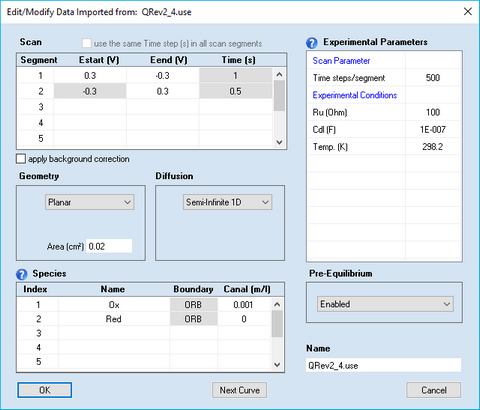
This command opens a dialog box that enables the user to view (or modify) the parameters imported from an experimental data file.
 If the Tab-Window: Experiments is empty the active simulation (in the Tab-Window: Simulations) is used as an template for creating a new experiment before starting the import of the data stored in the ASCII-file. Consequently, if the ASCII-file does only contain voltage/current couples, the parameters associated with the experiment (such as parameters referring to Scan, Pre-Equilibrium, Diffusion, Geometry or Experimental Parameters) will be those of the active simulation. Otherwise (i.e. if the Tab-Window: Experiments is not empty) the active experiment will be taken as the template. If the ASCII-file contains additional information (concerning Scan, Pre-Equilibrium, Diffusion, Geometry or Experimental Parameters) the parameters from the template will be overwritten by the imported ones.
If the Tab-Window: Experiments is empty the active simulation (in the Tab-Window: Simulations) is used as an template for creating a new experiment before starting the import of the data stored in the ASCII-file. Consequently, if the ASCII-file does only contain voltage/current couples, the parameters associated with the experiment (such as parameters referring to Scan, Pre-Equilibrium, Diffusion, Geometry or Experimental Parameters) will be those of the active simulation. Otherwise (i.e. if the Tab-Window: Experiments is not empty) the active experiment will be taken as the template. If the ASCII-file contains additional information (concerning Scan, Pre-Equilibrium, Diffusion, Geometry or Experimental Parameters) the parameters from the template will be overwritten by the imported ones.

 Disabled entries refer to data extracted from the imported curve which should not be modified by the user.
Disabled entries refer to data extracted from the imported curve which should not be modified by the user.
Most of the parameters have the same meaning as already described for cyclic voltammetry. The meaning and functionality of the Scan Parameters is as follows:
Scan Parameter:
•Scan segment, Estart (V), Eend (V), Time(s)
DigiElch provides a highly flexible way for defining the potential jumps executed in the course of a chrono-amperometric experiment. The definition is done in terms of scan segments characterized by starting potential, Estart (V), end-potential, Eend (V) and the time, Time (s), for which the end-potential is applied.
 Estart - values plotted on a gray background are "read only" and cannot be edited/modified. This ensures a "smooth scan" where the starting potential of a scan is always equal to the end potential of the previous scan.
Estart - values plotted on a gray background are "read only" and cannot be edited/modified. This ensures a "smooth scan" where the starting potential of a scan is always equal to the end potential of the previous scan.
•Check Box: use the same Time step (s) in each scan segment
Controls which kind of parameter appears as Scan Parameter. If unticked the input is done in terms of Time steps/segment, if ticked the parameter is Time step (s).
•Check Box: apply background correction
This check box is visible only if both Ru (Ohm) and Cd (F) are different from zero. The need for this option is similarly as demonstrated in the CV-example.
 This check box is visible only if Cdl (F) > 0 and Ru(Ohm) > 0.
This check box is visible only if Cdl (F) > 0 and Ru(Ohm) > 0.
•Time steps/segment
Defines how many time steps are executed in each scan segment for covering the time interval entered for time (s) . That means, if the Time (s) is different in each scan segment, the simulation is done using a different time interval (time step), Δt, in each scan segment.
•Time step (s)
If use the same Time step (s) in each scan segment has been selected the simulator is forced to use exactly the same time interval (time step), Δt, in each scan segment independently of the particular value of Time (s).
Removing scan segments:
A scan segment (and all subsequent scan segments) can be removed by entering an empty string for Eend (V). For instance, if a user wants that only the first scan segment is executed in Example 2, an empty string must be entered into the input field "Eend (V)" associated with the scan index 2.
